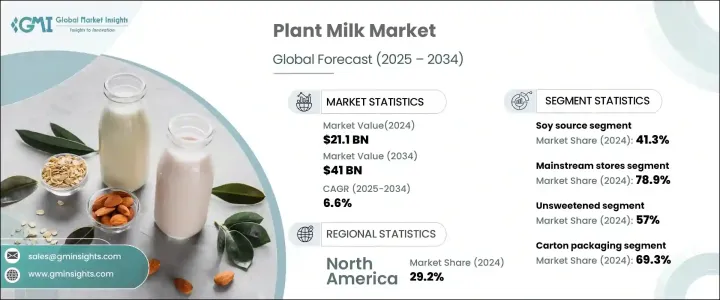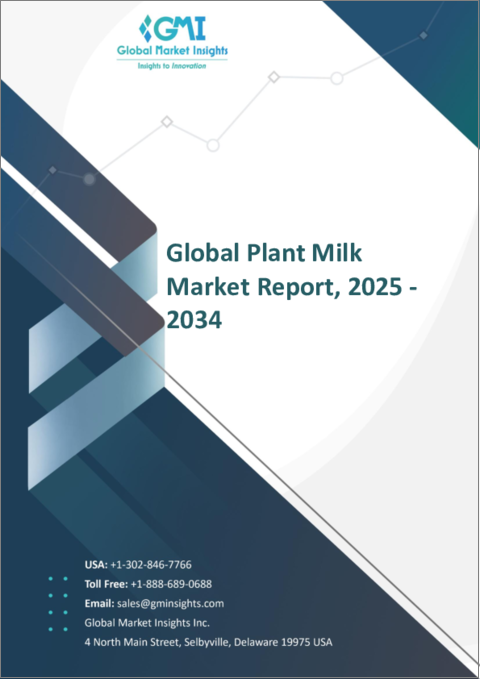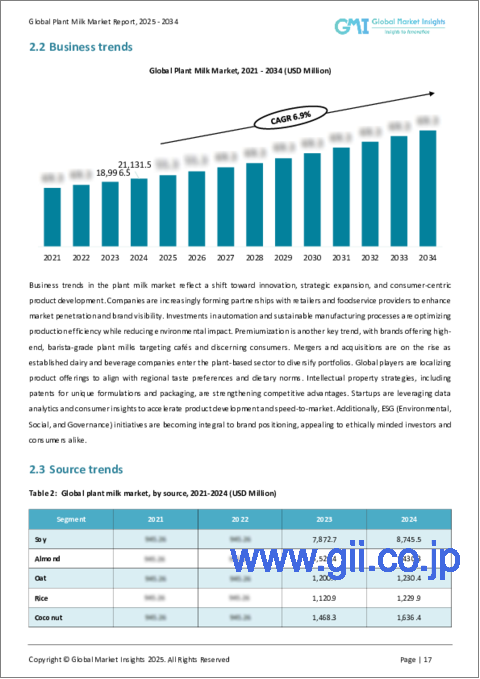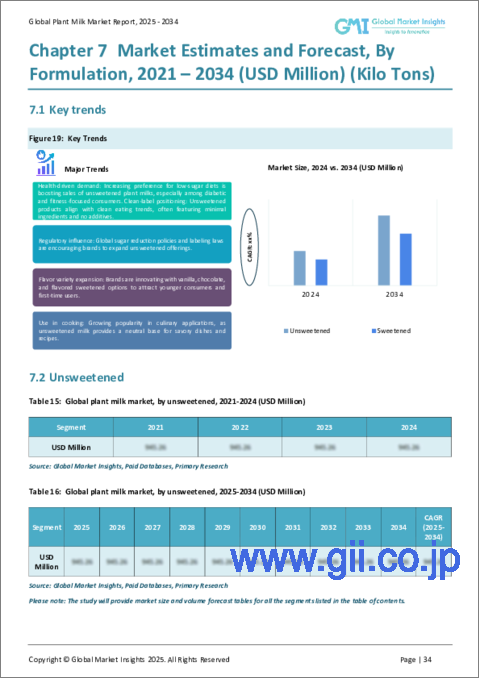|
|
市場調査レポート
商品コード
1698542
植物性ミルク市場の機会、成長促進要因、産業動向分析、2025年~2034年の予測Plant Milk Market Opportunity, Growth Drivers, Industry Trend Analysis, and Forecast 2025-2034 |
||||||
カスタマイズ可能
|
|||||||
| 植物性ミルク市場の機会、成長促進要因、産業動向分析、2025年~2034年の予測 |
|
出版日: 2025年02月06日
発行: Global Market Insights Inc.
ページ情報: 英文 220 Pages
納期: 2~3営業日
|
全表示
- 概要
- 目次
世界の植物性ミルク市場は2024年に211億米ドルとなり、2025年から2034年にかけてCAGR 6.6%で拡大すると予測されています。
この成長の原動力となっているのは、植物由来の食品に対する需要の増加、栄養強化、メーカー間の戦略的提携です。消費者は乳製品の代替品にシフトしており、生産者は植物性ミルクにカルシウム、ビタミンD、ビタミンB12などの必須栄養素を強化するよう促しています。この強化により、植物性ミルクは従来の乳製品に匹敵する代用品として位置付けられ、普及がさらに促進されます。

健康志向の消費者と持続可能性への関心も市場の拡大に寄与しています。酪農が環境に与える影響に対する認識と、植物由来の食生活への嗜好の高まりが、植物乳へのシフトを加速させています。さらに、数十年にわたる調査により、植物ベースの食事は慢性疾患の予防に役立つことが示唆されており、こうした代替食品に対する消費者の信頼が強まっています。
| 市場範囲 | |
|---|---|
| 開始年 | 2024 |
| 予測年 | 2025-2034 |
| 開始金額 | 211億米ドル |
| 予測金額 | 410億米ドル |
| CAGR | 6.6% |
市場は原料別に豆乳、アーモンド、オート麦、米、ココナッツ、その他の植物性オプションに区分されます。豆乳は、主にその高タンパク質含有量と手頃な価格により、2024年の総売上高の41.3%を占めました。アーモンドミルクは依然として健康志向の消費者に人気のある選択肢であり、オートミルクはそのクリーミーなテクスチャーで人気を博しています。ライスミルクは低アレルギー性で好まれ、そのまま飲めるシリアルや飲料の定番となっています。ココナッツミルクは料理やトロピカル飲料に広く使われ続けています。カシューミルク、エンドウ豆ミルク、ヘンプミルクといった新たな代替ミルクは、その高いタンパク質含有量とアレルゲンフリーの利点で注目を集めており、市場のイノベーションを促進しています。
植物ミルクは、主流小売店、専門店、eコマース・プラットフォームなど、さまざまな流通チャネルで広く販売されています。2024年には、主流小売店が78.9%のシェアで市場を独占し、消費者の入手しやすさが増すにつれてCAGR 11.4%で成長すると予測されています。セルフサービスの小売店は植物性ミルクをより手ごろな価格にしており、専門店はオーガニックや強化オプションでニッチ市場に対応しています。オンライン・プラットフォームは市場拡大において重要な役割を果たしており、消費者直販ブランドはより多くの消費者にリーチすることができます。
市場は剤形によっても区分され、2024年には無糖植物性ミルクが57%のシェアを占める。健康志向の高まりと糖尿病患者の増加が、低糖代替食品への需要を押し上げています。無糖の選択肢がフィットネス志向の消費者にアピールする一方で、加糖植物性ミルクは、追加的な加工コストのために価格が高くなるにもかかわらず、飲料やデザートに依然として人気があります。
包装の嗜好が市場をさらに形成しており、2024年にはカートン包装が総売上の69.3%を占める。この分野は、持続可能性への懸念と携帯用サービングを好む消費者の嗜好により、CAGR 11.7%で成長すると予想されます。カートン包装は環境に優しいという魅力でリードし、ボトル包装はプレミアムセグメントに対応し、パウチ包装は低コストで利便性を提供します。
北米は2024年の売上高シェア29.2%で植物ミルク市場をリードしているが、アジア太平洋地域が最も高い成長を遂げようとしています。中国やインドのような国々では、都市化、可処分所得の増加、食生活の変化が需要を促進しています。持続可能な食品生産を支援する政府の取り組みと、植物性食生活の採用増加が市場の成長をさらに強化しています。植物性ミルクはすでに牛乳小売総売上の15%を占めており、市場は今後も拡大が続くと思われます。
目次
第1章 調査手法と調査範囲
- 市場範囲と定義
- 基本推定と計算
- 予測計算
- データソース
- 1次調査と検証
第2章 エグゼクティブサマリー
第3章 業界洞察
- エコシステム分析
- バリューチェーンに影響を与える要因
- 利益率分析
- ディスラプション
- 将来の展望
- メーカー
- 流通業者
- サプライヤーの状況
- 利益率分析
- 主要ニュース
- 規制状況
- 影響要因
- 促進要因
- 栄養強化の強化
- 植物性食品に対する消費者の需要の高まり
- 業界関係者間の協力
- チャネル
- 業界の潜在的リスク&課題
- 激しい競合
- 従来の乳製品と比較した場合の価格の高騰
- 促進要因
- 成長可能性分析
- ポーター分析
- PESTEL分析
第4章 競合情勢
- イントロダクション
- 企業シェア分析
- 競合のポジショニング・マトリックス
- 戦略展望マトリックス
第5章 市場推計・予測:原料別、2021年~2034年
- 主要動向
- 大豆
- アーモンド
- オート麦
- 米
- ココナッツ
- その他
第6章 市場推計・予測:流通チャネル別、2021年~2034年
- 主要動向
- 主要店舗
- 専門店
- その他(オンライン、自然食品店)
第7章 市場推計・予測:製剤別、2021年~2034年
- 主要動向
- 無糖
- 加糖
第8章 市場推計・予測:包装材別、2021年~2034年
- 主要動向
- カートン包装
- ボトル
- パウチ
第9章 市場推計・予測:地域別、2021年~2034年
- 主要動向
- 北米
- 米国
- カナダ
- 欧州
- ドイツ
- 英国
- フランス
- スペイン
- イタリア
- ロシア
- アジア太平洋
- 中国
- インド
- 日本
- オーストラリア
- 韓国
- ラテンアメリカ
- ブラジル
- メキシコ
- 中東・アフリカ
- サウジアラビア
- 南アフリカ
- アラブ首長国連邦
第10章 企業プロファイル
- Blue Diamond Growers
- Califia Farms
- Danone
- Elmhurst 1925
- Mooala
- Nestle
- Oatly AB
- Pacific Foods
- Plenish
- Ripple Foods
- SunOpta Inc.
- The Hain Celestial Group
- WhiteWave Foods
The Global Plant Milk Market was valued at USD 21.1 billion in 2024 and is projected to expand at a CAGR of 6.6% from 2025 to 2034. This growth is fueled by increasing demand for plant-based foods, nutritional enhancements, and strategic partnerships among manufacturers. Consumers are shifting toward dairy alternatives, prompting producers to fortify plant milk with essential nutrients such as calcium, vitamin D, and vitamin B12. This fortification positions plant milk as a comparable substitute for traditional dairy products, further driving adoption.

Health-conscious consumers and sustainability concerns are also contributing to market expansion. Awareness of the environmental impact of dairy farming and the growing preference for plant-based diets are accelerating the shift toward plant milk. Additionally, decades of research suggest that plant-based diets help prevent chronic diseases, reinforcing consumer confidence in these alternatives.
| Market Scope | |
|---|---|
| Start Year | 2024 |
| Forecast Year | 2025-2034 |
| Start Value | $21.1 Billion |
| Forecast Value | $41 Billion |
| CAGR | 6.6% |
The market is segmented by source into soy, almond, oat, rice, coconut, and other plant-based options. Soy milk accounted for 41.3% of total revenue in 2024, primarily due to its high protein content and affordability. Almond milk remains a popular choice for health-focused consumers, while oat milk has gained traction due to its creamy texture. Rice milk is preferred for its hypoallergenic properties, making it a staple in ready-to-drink cereals and beverages. Coconut milk continues to be widely used in cooking and tropical beverages. Emerging alternatives, such as cashew, pea, and hemp milk, are gaining attention for their high protein content and allergen-free benefits, fostering innovation in the market.
Plant milk is widely available across various distribution channels, including mainstream retailers, specialty stores, and e-commerce platforms. In 2024, mainstream stores dominated the market with a 78.9% share and are projected to grow at a CAGR of 11.4% as consumer accessibility increases. Self-service retailers are making plant milk more affordable, while specialty stores cater to niche markets with organic and fortified options. Online platforms play a vital role in market expansion, allowing direct-to-consumer brands to reach a broader audience.
The market is also segmented by formulation, with unsweetened plant milk capturing 57% of the share in 2024. Rising health consciousness and increasing cases of diabetes have driven demand for low-sugar alternatives. While unsweetened options appeal to fitness-oriented consumers, sweetened plant milk remains popular in beverages and desserts, despite higher prices due to additional processing costs.
Packaging preferences further shape the market, with carton packaging accounting for 69.3% of total sales in 2024. This segment is expected to grow at a CAGR of 11.7%, driven by sustainability concerns and consumer preference for portable servings. Cartons lead due to their eco-friendly appeal, bottles cater to premium segments, and pouches offer convenience at a lower cost.
North America led the plant milk market with a 29.2% revenue share in 2024, but the Asia-Pacific region is poised for the highest growth. Urbanization, rising disposable income, and changing dietary habits in countries like China and India are fueling demand. Government initiatives supporting sustainable food production and the increasing adoption of plant-based diets further strengthen market growth. With plant-based milk already comprising 15% of total retail milk sales, the market is set to witness continued expansion.
Table of Contents
Chapter 1 Methodology & Scope
- 1.1 Market scope & definition
- 1.2 Base estimates & calculations
- 1.3 Forecast calculation
- 1.4 Data sources
- 1.4.1 Primary
- 1.4.2 Secondary
- 1.4.2.1 Paid sources
- 1.4.2.2 Public sources
- 1.5 Primary research and validation
- 1.5.1 Primary sources
- 1.5.2 Data mining sources
Chapter 2 Executive Summary
- 2.1 Industry synopsis, 2021-2034
Chapter 3 Industry Insights
- 3.1 Industry ecosystem analysis
- 3.1.1 Factor affecting the value chain
- 3.1.2 Profit margin analysis
- 3.1.3 Disruptions
- 3.1.4 Future outlook
- 3.1.5 Manufacturers
- 3.1.6 Distributors
- 3.2 Supplier landscape
- 3.3 Profit margin analysis
- 3.4 Key news & initiatives
- 3.5 Regulatory landscape
- 3.6 Impact forces
- 3.6.1 Growth drivers
- 3.6.1.1 Enhanced nutritional fortification
- 3.6.1.2 Increasing consumer demand for plant-based diets
- 3.6.1.3 Collaboration between industry players
- 3.6.1.4 channels
- 3.6.2 Industry pitfalls & challenges
- 3.6.2.1 Intense competition.
- 3.6.2.2 Higher prices compared to conventional dairy milk
- 3.6.1 Growth drivers
- 3.7 Growth potential analysis
- 3.8 Porter's analysis
- 3.9 PESTEL analysis
Chapter 4 Competitive Landscape, 2024
- 4.1 Introduction
- 4.2 Company market share analysis
- 4.3 Competitive positioning matrix
- 4.4 Strategic outlook matrix
Chapter 5 Market Estimates and Forecast, By Source, 2021 – 2034 (USD Billion) (Kilo Tons)
- 5.1 Key trends
- 5.2 Soy
- 5.3 Almond
- 5.4 Oat
- 5.5 Rice
- 5.6 Coconut
- 5.7 Others
Chapter 6 Market Estimates and Forecast, By Distribution Channel, 2021 – 2034 (USD Billion) (Kilo Tons)
- 6.1 Key trends
- 6.2 Mainstream stores
- 6.3 Specialty stores
- 6.4 Others (online, natural food stores)
Chapter 7 Market Estimates and Forecast, By Formulation, 2021 – 2034 (USD Billion) (Kilo Tons)
- 7.1 Key trends
- 7.2 Unsweetened
- 7.3 Sweetened
Chapter 8 Market Estimates and Forecast, By Packaging, 2021 – 2034 (USD Billion) (Kilo Tons)
- 8.1 Key trends
- 8.2 Carton packaging
- 8.3 Bottles
- 8.4 Pouches
Chapter 9 Market Estimates and Forecast, By Region, 2021 – 2034 (USD Billion) (Kilo Tons)
- 9.1 Key trends
- 9.2 North America
- 9.2.1 U.S.
- 9.2.2 Canada
- 9.3 Europe
- 9.3.1 Germany
- 9.3.2 UK
- 9.3.3 France
- 9.3.4 Spain
- 9.3.5 Italy
- 9.3.6 Russia
- 9.4 Asia Pacific
- 9.4.1 China
- 9.4.2 India
- 9.4.3 Japan
- 9.4.4 Australia
- 9.4.5 South Korea
- 9.5 Latin America
- 9.5.1 Brazil
- 9.5.2 Mexico
- 9.6 Middle East and Africa
- 9.6.1 Saudi Arabia
- 9.6.2 South Africa
- 9.6.3 UAE
Chapter 10 Company Profiles
- 10.1 Blue Diamond Growers
- 10.2 Califia Farms
- 10.3 Danone
- 10.4 Elmhurst 1925
- 10.5 Mooala
- 10.6 Nestle
- 10.7 Oatly AB
- 10.8 Pacific Foods
- 10.9 Plenish
- 10.10 Ripple Foods
- 10.11 SunOpta Inc.
- 10.12 The Hain Celestial Group
- 10.13 WhiteWave Foods





